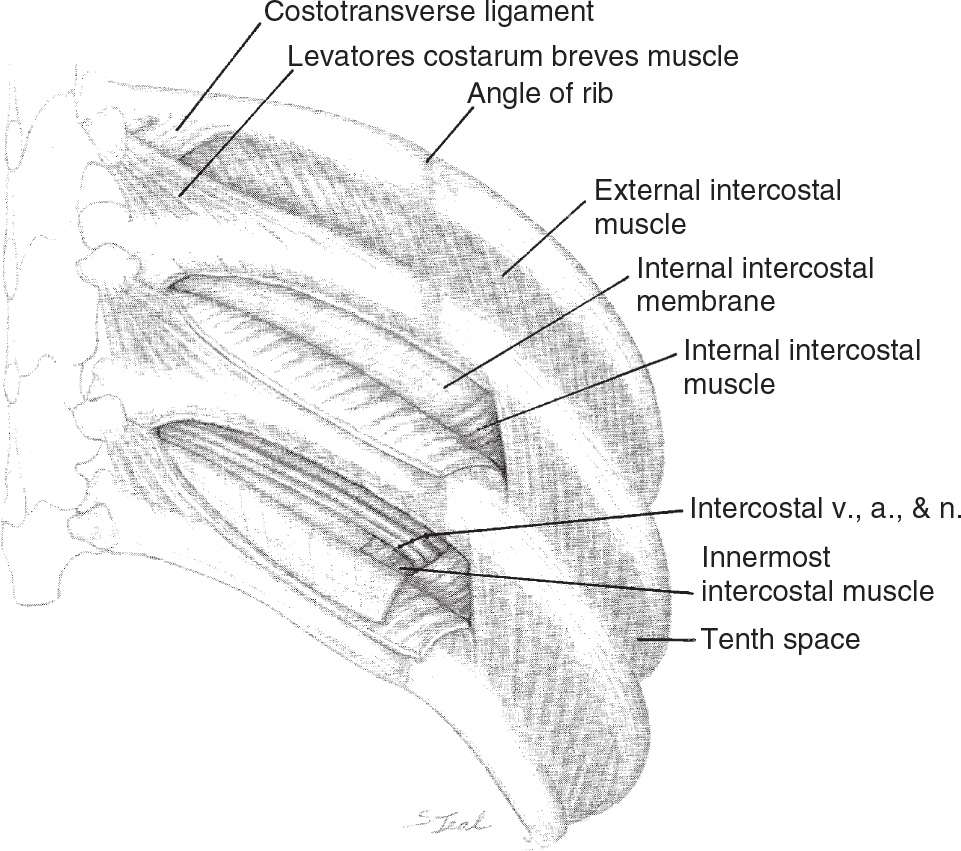![]() Used to provide analgesia for acute and chronic pain conditions affecting the thorax including the following:
Used to provide analgesia for acute and chronic pain conditions affecting the thorax including the following:
![]() Significant rib fractures causing hypoventilation, splinting respirations, or atelectasis
Significant rib fractures causing hypoventilation, splinting respirations, or atelectasis
![]() Chest wall/upper abdominal surgery: Thoracotomy, thoracostomy, gastrostomy tube placement
Chest wall/upper abdominal surgery: Thoracotomy, thoracostomy, gastrostomy tube placement
![]() Neuralgia: Posttraumatic, postherpetic (acute herpes simplex virus [HSV] infection), metastatic neoplasm of vertebral body
Neuralgia: Posttraumatic, postherpetic (acute herpes simplex virus [HSV] infection), metastatic neoplasm of vertebral body
CONTRAINDICATIONS
![]() Contralateral pneumothorax
Contralateral pneumothorax
![]() Inadvertant creation of bilateral pneumothorax puts the patient at unnecessarily high health risk
Inadvertant creation of bilateral pneumothorax puts the patient at unnecessarily high health risk
![]() Relative contraindications
Relative contraindications
![]() Routine rib fracture that is tolerating oral analgesia
Routine rib fracture that is tolerating oral analgesia
![]() Local infection
Local infection
![]() Lack of surgical expertise
Lack of surgical expertise
![]() Serious hemostasis disorders, such as platelets <50,000 or international normalized ratio (INR) >1.0
Serious hemostasis disorders, such as platelets <50,000 or international normalized ratio (INR) >1.0
RISK/CONSENT ISSUES
![]() Procedure can cause local pain. Local anesthesia will be given.
Procedure can cause local pain. Local anesthesia will be given.
![]() Needle puncture can cause local bleeding, which is usually minimal. More significant bleeding can occur if the intercostal artery is punctured but care will be taken to avoid the artery.
Needle puncture can cause local bleeding, which is usually minimal. More significant bleeding can occur if the intercostal artery is punctured but care will be taken to avoid the artery.
![]() The needle could puncture the lung and cause a collapsed lung (pneumothorax). The risk is <1.5% and we have definitive treatment to reinflate the lung if the situation arises.
The needle could puncture the lung and cause a collapsed lung (pneumothorax). The risk is <1.5% and we have definitive treatment to reinflate the lung if the situation arises.
![]() Potential for introducing infection exists; however, this is extremely rare. Sterile technique will be utilized.
Potential for introducing infection exists; however, this is extremely rare. Sterile technique will be utilized.
LANDMARKS
![]() The following landmarks are useful to determine the position of the desired rib:
The following landmarks are useful to determine the position of the desired rib:
![]() 7th rib is the lowest rib covered by the angle of the scapula
7th rib is the lowest rib covered by the angle of the scapula
![]() 12th rib is the last rib palpable (FIGURE 78.1)
12th rib is the last rib palpable (FIGURE 78.1)
![]() The intercostal nerves (ICNs) course in the subcostal groove parallel to the ribs. Within the subcostal groove, the ICNs lie inferior to the intercostal arteries (vein, artery, nerve).
The intercostal nerves (ICNs) course in the subcostal groove parallel to the ribs. Within the subcostal groove, the ICNs lie inferior to the intercostal arteries (vein, artery, nerve).
![]() Most ICN blocks are performed between the posterior and midaxillary line at a point proximal to the origin of the lateral cutaneous nerve. In adults, this correlates with 6 to 8 cm from the spinous process at the angle of the rib.
Most ICN blocks are performed between the posterior and midaxillary line at a point proximal to the origin of the lateral cutaneous nerve. In adults, this correlates with 6 to 8 cm from the spinous process at the angle of the rib.
TECHNIQUE
![]() Collect Equipment
Collect Equipment
![]() Standard 25-gauge needle and 22-gauge 1.5-inch short-bevel needle
Standard 25-gauge needle and 22-gauge 1.5-inch short-bevel needle
![]() Sterile draping and sterile gloves
Sterile draping and sterile gloves
![]() Povidone–iodine solution or chlorhexidine
Povidone–iodine solution or chlorhexidine

FIGURE 78.1 Exposure of the posterior part of intercostal spaces 8, 9, and 10. Note that the intercostal vein (v.), artery (a.), and nerve (n.) lie between the internal intercostal muscle and the innermost intercostal muscle layers. From the intervertebral foramen to the angle of the rib, the intercostal vessels and nerves are covered by the internal intercostal membrane. (Reprinted with permission from Blevins CE. Anatomy of the thorax. In: Shields TW, LoCicero J III, Ponn RB, et al. eds. General Thoracic Surgery. Vol 1. 6th ed. Philadelphia, PA: Lippincott Williams & Wilkins; 2005:11.)
Stay updated, free articles. Join our Telegram channel

Full access? Get Clinical Tree


